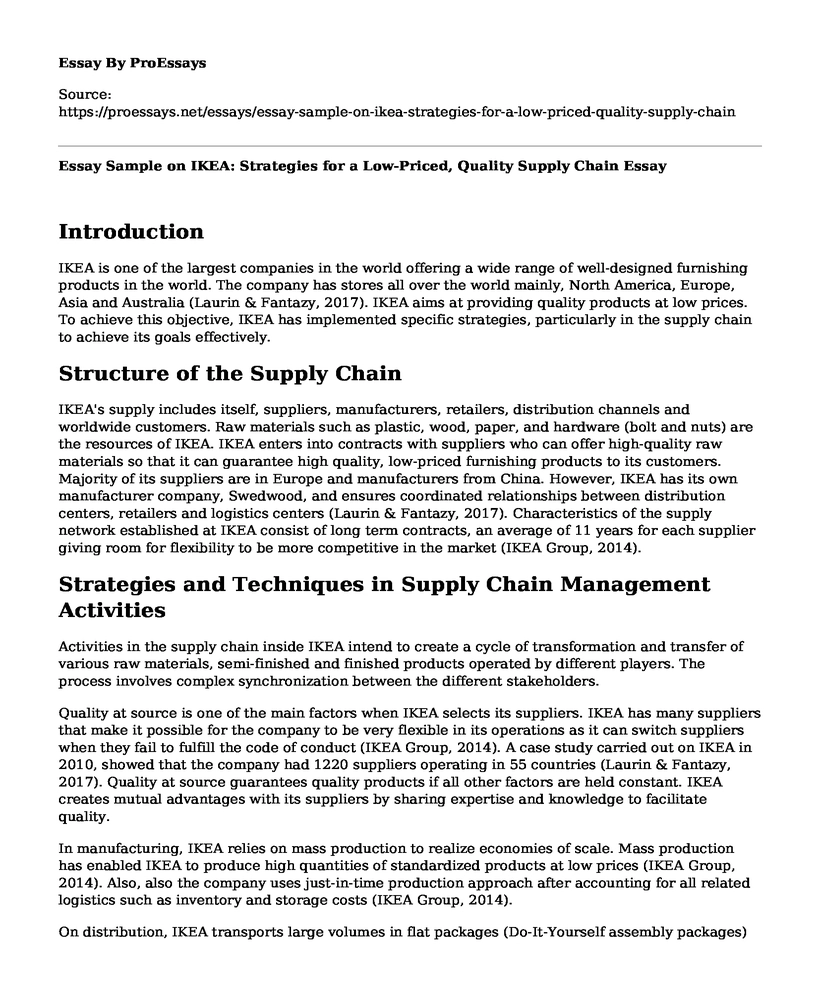Introduction
IKEA is one of the largest companies in the world offering a wide range of well-designed furnishing products in the world. The company has stores all over the world mainly, North America, Europe, Asia and Australia (Laurin & Fantazy, 2017). IKEA aims at providing quality products at low prices. To achieve this objective, IKEA has implemented specific strategies, particularly in the supply chain to achieve its goals effectively.
Structure of the Supply Chain
IKEA's supply includes itself, suppliers, manufacturers, retailers, distribution channels and worldwide customers. Raw materials such as plastic, wood, paper, and hardware (bolt and nuts) are the resources of IKEA. IKEA enters into contracts with suppliers who can offer high-quality raw materials so that it can guarantee high quality, low-priced furnishing products to its customers. Majority of its suppliers are in Europe and manufacturers from China. However, IKEA has its own manufacturer company, Swedwood, and ensures coordinated relationships between distribution centers, retailers and logistics centers (Laurin & Fantazy, 2017). Characteristics of the supply network established at IKEA consist of long term contracts, an average of 11 years for each supplier giving room for flexibility to be more competitive in the market (IKEA Group, 2014).
Strategies and Techniques in Supply Chain Management Activities
Activities in the supply chain inside IKEA intend to create a cycle of transformation and transfer of various raw materials, semi-finished and finished products operated by different players. The process involves complex synchronization between the different stakeholders.
Quality at source is one of the main factors when IKEA selects its suppliers. IKEA has many suppliers that make it possible for the company to be very flexible in its operations as it can switch suppliers when they fail to fulfill the code of conduct (IKEA Group, 2014). A case study carried out on IKEA in 2010, showed that the company had 1220 suppliers operating in 55 countries (Laurin & Fantazy, 2017). Quality at source guarantees quality products if all other factors are held constant. IKEA creates mutual advantages with its suppliers by sharing expertise and knowledge to facilitate quality.
In manufacturing, IKEA relies on mass production to realize economies of scale. Mass production has enabled IKEA to produce high quantities of standardized products at low prices (IKEA Group, 2014). Also, also the company uses just-in-time production approach after accounting for all related logistics such as inventory and storage costs (IKEA Group, 2014).
On distribution, IKEA transports large volumes in flat packages (Do-It-Yourself assembly packages) minimizing the number of trips thus reducing transportation costs and carbon footprint. Lastly, the company communicates with retailers and customers using its catalog and website. IKEA retail stores provide customers with a physical experience which increases engagement.
Contribution to Success of the Company
IKEA has been successful in the implementation of supply chain management strategies in fostering a mutual relationship with suppliers, manufacturers, the distribution channels, its retailers and most importantly its worldwide customers. This has enabled it to emerge as the largest and leading furnishing company in the world. A crucial part of IKEA's success is associated with productive relationships and communication with different players in the supply chain. A good relationship with its suppliers and manufacturers enables it to acquire materials and products at reasonable prices. Entering into long-term contracts with its suppliers lowers the prices of the products further. IKEA code of conduct offers guidelines to help suppliers and manufacturers reduce activities that would have an impact on the environment. Do-it-Your assembly lowers packaging costs and transportation costs.
References
IKEA Group. (2014). IKEA Group Yearly Summary. Retrieved from: http://www.ikea.com/ms/en_US/pdf/yearly_summary/ikea-group-yearly-summary-fy14.pdf
Laurin, F., & Fantazy, K. (2017). Sustainable supply chain management: a case study at IKEA. Transnational Corporations Review, 9(4), 309-318. DOI: 10.1080/19186444.2017.1401208
Cite this page
Essay Sample on IKEA: Strategies for a Low-Priced, Quality Supply Chain. (2023, Jan 12). Retrieved from https://proessays.net/essays/essay-sample-on-ikea-strategies-for-a-low-priced-quality-supply-chain
If you are the original author of this essay and no longer wish to have it published on the ProEssays website, please click below to request its removal:
- 'Good' and 'Bad' Adverts - Paper Example
- Essay Sample on Dolce & Gabbana Ad Provokes Public Outrage in China
- Anti-Smoking Campaign Advert Analysis
- Organizations: Enhancing Cybersecurity With ML & AI - Annotated Bibliography
- Research Paper on 40 Years in Business: Strategies to Outsmart Competitors
- Optima Health: Progressive & Flexible Health Care Services - Essay Sample
- Conflict: Interparty Disagreements in Organizations/Groups - Essay Sample







